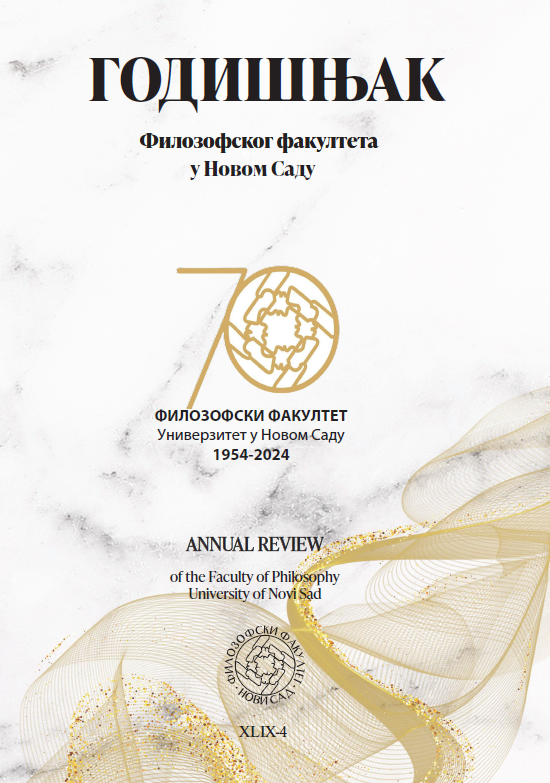PHRASEOLOGISM WITH THE LEXEME SOLE / SUNCE IN ITALIAN AND SERBIAN LANGUAGE
Main Article Content
Abstract
The paper deals with the analysis of Serbian and Italian phraseology, which were observed with the help of comparative analysis. The paper consists of 34 phraseological units containing the lexeme сунце / il sole. Phraseologisms that are studied are established, predetermined language units with complete semantic content and distinct expressiveness, and the paper contains only phraseologisms in a narrower sense. Phraseologisms in both languages represent a composition of several words that define a certain situation, fact or event. Observing the cultural aspect, the Sun is seen in phraseology from the point of view of a people. The picture of the reality of these languages and the conceptualization of the world is presented. The work also includes comparative and linguistic and cultural analysis. The aim of the paper is to determine the degree of similarity and difference in terms of phraseology in the Italian and Serbian languages. Comparative analysis serves to determine the degree of structural-semantic equivalence. Differences on the phraseological level can be seen by taking into account genetic affinity, cultural heritage and cultural-linguistic contacts. With this work, we want to point out what are the similarities and what are the differences when it comes to the perception of the Sun, and thereby show the cultural and linguistic similarities and differences in the Serbian and Italian languages. Тhe paper shows that there is a semantic similarity in phraseology containing the lexeme sun. Тhe cultural aspect is shown, which proves that people had the same view of the sun and that it represented the source of life, and because of this, there is a great similarity and a large number of phraseology in these two languages.
Downloads
Article Details

This work is licensed under a Creative Commons Attribution-ShareAlike 4.0 International License.
References
Alfieri, G. (1997). Modi di dire nell’italiano di ieri e di oggi: un problema di stile collettivo. Università di Catania.
Biderman, H. (2004). Rečnik simbola. Beograd: Plato.
Блатешић, А. (2021). Наслеђе. Народне представе о сунцу и месецу у фраземима и паремијама италијанског и српског језика. 63-79
Чајкановић, В. (1918). Стара српска религија и митологија. Ниш: Просвета.
Ђорђевић, Т. (1958). Природа у веровању и предању нашега народа. Београд: Научно дело.
Frank, A. (2014). Diario. Torino. Einaudi.
Manzoni, A. (2012). I promessi sposi. Bologna. Edizioni Giuseppe Malpiero.
Матешић, Ј. (1982). Фразеолошки рјечник хрватскога или српског језика. Загреб: Школска књига.
Миловановић, К. (1994). Речник симбола. Београд: Народно дело.
Мршевић Радовић, Д. (2008). Фразеологија и национална култура. Београд: Штампа Чигоја.
Мршевић Радовић, Д. (1987). Фразеолошке глаголско-именичке синтагме. Београд: Филолошки факултет.
Pittano, G. (1992). Dizionario dei modi di dire, proverbi e locuzioni. Bologna: Zanichelli.
Quartu, M, Rossi E. (2012). Dizionario dei modi di dire della lingua italiana. Hoepli.
РМС: Речник српскохрватскога књижевног језика. Нови Сад‒Загреб: Матица српска‒Матица хрватска, 1967‒1976.
САНУ: Речника српскохрватског књижевног и народног језика. Београд: Институт за српскохрватски језик, 1959.
Sorge, P. (2001). Dizionario dei modi di dire della lingua italiana. Roma: Grandi Manuali Newton.
Стефановић Караџић, В. (1899). Српске народне пјесме V: Пјесме јуначке најстарије и средњијех времена. Београд: Државна штампарија.
Тонкин, И. (2004). Dizionario fraseologico italiano-bulgaro. Софија: Romanistika.
Treccani (2008): A.A.V.V. Treccani. Dizionario della Lingua Italiana. Istituto della Enciclopedia Italiana fondata da Giovanni Treccani S.p.A. https://www.treccani.it/enciclopedia/elen- co-opere/Vocabolario_on_line
Вуловић, Н. (2015). Српска фразеологија и религија. Београд: Институт за српски језик САНУ.




